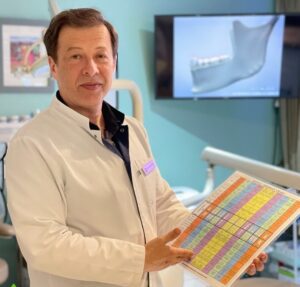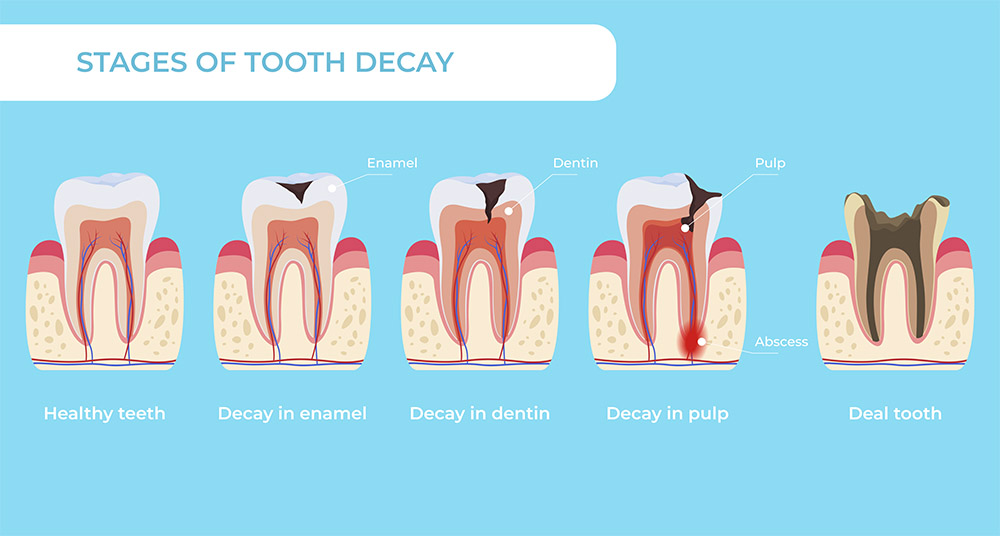Caries is a common disease that spares neither adults nor children. Tooth damage is accompanied by pain and discomfort, and it can appear even in individuals practicing regular oral hygiene. So how can you eliminate caries and ensure dental health?
In this article, we will tell you:
- How it forms.
- Why it occurs.
- The types of caries and how to identify them.
- Effective prevention methods.
- Modern treatment methods.
Do not let caries ruin your smile! Make an appointment with a dentist in Fort Lauderdale!
What is a dental cavity?
The process of destruction and demineralization of the tooth's hard tissues. Bacteria and food residues form dental plaque are pathogenic microorganisms that break down carbohydrates. In doing so, they release acids, destroying enamel and dentin.
If caries is not treated, it will continue to penetrate into the deeper layers of the tooth. The carious process begins with the formation of a hole or cavity on the surface of the enamel. It then affects the dentin – a softer tissue under the enamel. Pain sensations and sensitivity arise, and it reaches the pulp, where the tooth nerve and blood vessels are located.
When the infection reaches the pulp, an acute pain syndrome occurs. If a dentist is not consulted at this stage, the infection leads to pulpitis – inflammation of the tooth nerve. An abscess or cyst forms around the tooth root. The tooth can no longer be saved – it has to be removed to prevent the infection from spreading to adjacent teeth and tissues.

Boris Lipovetskiy
Dental experience – 30 years
How common is tooth decay?
Caries is one of the most common diseases in the world. About 60-90% of children and almost 100% of adults encounter this pathology to varying degrees. It is found practically in all countries, on all continents.
The prevalence is related to a number of factors:
- Excessive consumption of sugar, carbohydrates.
- Non-compliance with oral care hygiene rules.
- Lack of regular visits to the dentist for preventive examinations, professional cleanings.
- Use of tobacco, alcohol
Where can it appear?
- On smooth surfaces – the lateral sides of the teeth that usually adjoin the neighboring ones. In these areas, the pathology is hard to notice in the initial stage of development. It can progress unnoticed until it leads to the formation of a carious cavity or affects the dentin. Regular use of dental floss and thorough toothbrushing can prevent the development of this form and even halt its progress.
- On the chewing surface – the most common form. Molars have many pits and ridges that are harder to clean. Dental plaque forms there, where pathogenic bacteria actively multiply. The acids they release destroy the enamel. Carious cavities appear.
- At the root – the carious process affects the root part of the tooth. This can happen due to gum recession – loose adhesion of the mucous membrane to the tooth roots or their exposure. The pathology is also provoked by an incorrect edge of a filling. It causes pain, sensitivity when consuming cold/hot beverages. It can lead to inflammation of the tooth nerve.
Professional cleaning – the best approach to tooth care!
Professional dental cleaning ensures the removal of dental plaque/tartar and prevents the development of caries and other dental problems. Don't wait for pain or discomfort to appear. Regular teeth cleaning at the dentist's office ensures a healthy smile without the need for treatment.
Gums also suffer from poor oral hygiene!
The accumulation of dental plaque/tartar on the teeth causes gum inflammation. The risk of developing gingivitis and periodontitis increases. Proper hygiene plays a key role both in preventing caries and in reducing the risk of gum inflammation.
Do you have a cavity?
Keep an eye out for the following symptoms if you think you might be developing a cavity:
- Tooth sensitivity when in contact with cold, hot, or sweet food.
- Pain while eating or spontaneous sharp pain.
- Dark spots or pits on the enamel.
- Breath with an unpleasant odor.
- Redness, bleeding of the gums during cleaning.
Bacteria in the oral cavity accumulate on the tooth surface, forming plaque. During their metabolism, they produce acids. These chemical compounds attack the minerals in the tooth enamel and gradually - the enamel layer is demineralized and destroyed. If the process is not halted, the dentin gets damaged. Carious cavities form.

-
Bacteria
Food residues (especially carbohydrates, sugar) serve as food for pathogenic bacteria. They produce acids that destroy the enamel
-
Insufficient hygiene
Inadequate cleaning of the dental arch (especially molars/premolars) allows bacteria and food residues to remain on the enamel and act destructively
-
Acidic products
Increasing acidity in the mouth promotes enamel destruction. It softens and becomes more vulnerable to the occurrence of carious cavities
-
Decreased saliva production
Saliva neutralizes acids, protects teeth, and washes food and plaque off them. Its lack increases the risk of disease onset
-
Frequent snacking
Additional meals provide bacteria with more material for acid production, which destroys the enamel
-
Old fillings
Worn or damaged dental fillings create roughness where plaque easily accumulates. This complicates cleaning and promotes caries development around the structure
-
Gum recession
Older people more commonly experience gum recession. With age, they lose natural protection, recede, and leave tooth roots unprotected, making them more vulnerable to pathology
-
Genetic factors
Some people are more predisposed to caries, having softer enamel due to genetic traits
How do we diagnose tooth decay?
The diagnosis includes:
Examination The doctor visually inspects the teeth, looking for dark spots or pits on the tooth surface. The patient is asked about the nature of pain – when it began, its intensity, and frequency. Whether there is a reaction to heat, cold, or sweets is also explored. This information helps the doctor determine the degree of pathology development.
Tactile Examination The dentist uses a probe to accurately determine the degree and location of decay. Carious areas are typically softer than healthy teeth. The patient's reaction to a stream of cold water may also be assessed. If the tooth reacts painfully to it, it indicates the presence of a disease.
Radiography X-ray images reveal carious changes in the initial stage, which are not visible to the naked eye. They detect pathologies and hidden carious cavities.
In the Advanced Dental Wellness Center, we utilize modern digital X-ray imaging in the 3D Imagine format. This technology provides our patients with highly precise, detailed diagnostics. Using three-dimensional images, we can accurately assess the condition of teeth and surrounding tissues, developing a proper treatment plan. This method possesses a high processing speed and reduced radiation dose, ensuring the procedure is safe and comfortable for our patients.
Treatment of Cavities
At the first signs of cavities, it's recommended to promptly consult a doctor. Early detection and treatment of the pathology help prevent its spread and preserve the teeth.

Ways to Treat Decay in Our Center
The procedure for restoring teeth that are damaged or affected by caries. It eliminates sensitivity – a dental filling prevents the penetration of bacteria and infection inside the tooth.
How does the procedure go?
- The doctor conducts an examination and diagnosis, determining the degree of carious damage.
- Chooses a material for filling, depending on the location and size of the damage.
- Uses local anesthesia to temporarily block nerve signals in the tooth and surrounding tissues.
- Removes affected areas using specialized tools and prepares the cavity for the filling. Utilizes a laser to remove carious cavities without pain and injuring healthy surrounding structures.
- Forms the filling inside the oral cavity using the selected material. Aligns it to match the patient's other teeth and checks the occlusion.
Restorative inserts/overlays for treating damaged or decayed teeth, utilized when it's too late for fillings and too early for crowns.
- Inlay – an insert for restoring a damaged part of a tooth inside its circumference. Used when the damage is minor and does not affect the side surfaces.
- Onlay – an overlay for restoring not only the internal part of a tooth but one or more lateral surfaces as well.
They are durable and are made from porcelain, E-max ceramics, or zirconium dioxide. Teeth Inlays and onlays require the removal of minimal volume of healthy enamel.
How does the procedure go?
- The doctor assesses the condition of the tooth, the degree of its destruction, and takes an X-ray. The doctor then chooses between Inlay or Onlay and the material for restoration.
- Takes an impression or performs digital scanning to acquire the accurate shape of the damaged tooth, transmitting the data to the laboratory.
- Cements the ready-made inlay or onlay in the damaged area.
- Checks the interaction of the teeth considering the installed structure, adjusting contacts.
A restorative structure in the form of a cap. It is placed over the existing tooth, covering its top part. Crowns are used after treating serious cavities, trauma, or for cosmetic purposes – when a filling cannot handle the damage. A dental crown restores the function and appearance of a damaged tooth and prevents its further decay.
How does the procedure go?
- The dentist examines the defective tooth and takes an X-ray.
- Prepares the surface – removes affected tissues. Shapes the tooth so that the crown fits tightly and stably.
- Takes an impression or a scan, which is sent to the dental laboratory. The crown is made exactly to the shape and size of the tooth.
- Places the crown under local anesthesia using dental cement.
- Checks the bite, how the crown interacts with the other teeth.

Boris Lipovetskiy
Dentist with 30 years of experience
Ozone Therapy as Part of a Holistic Approach to Health!
Treating cavities with ozone is a safer and less invasive alternative to traditional treatment methods.
- Possesses potent antimicrobial properties.
- Capable of destroying bacteria and viruses.
- Restores the mineral composition of enamel, strengthens it.
- Activates natural healing processes in the body.
- Preserves healthy cells, reanimates damaged tissues.
Ozone therapy is a natural and effective solution for oral health care. I recommend it for treating the early stages of cavities.
Where Can I Treat Cavity?
«Are you looking for accessible and safe cavity treatment? I invite you to the Advanced Dental Wellness Center! Our experienced dentists provide quality cavity treatment near Fort Lauderdale. In our dental office, we use safe and natural methods of tooth restoration that also enhance overall health. Regardless of the stage of the disease, we offer patients a quick solution to the problem. Restore health to your smile without overpaying!» Dr. B. Lipovetskiy

Here are some recommendations:
-
Take a course of vitamins D3+K2 and C for immunity
-
Use fluoride-free toothpastes
-
Eat fruits and vegetables with reduced sugar content
-
Rinse your mouth with water after acidic foods
-
Visit the dentist regularly for professional cleaning and check-ups (twice a year)
-
Eat more vegetables and fruits to improve saliva production
-
Consume sweet products/drinks in large amounts and not clean your teeth afterward
-
Ignore pain or sensitivity in the teeth
-
Excessively consume alcohol and tobacco
-
Neglect regular professional oral hygiene
Q&A
No. Fillings, crowns, and other constructions are matched to the color of the patient's other teeth. After installation, they do not stand out against the general background and look natural. Whitening is not required.


